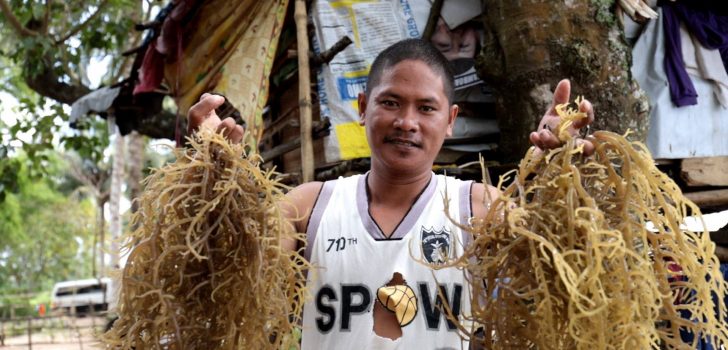 Julie Tagbo happily shows the seaweeds from his farm (Photo by Ramil L. Sotto)
Julie Tagbo happily shows the seaweeds from his farm (Photo by Ramil L. Sotto) Seaweeds to uplift marginalized fisherfolk from poverty
Purok Malasugi of Barangay Bulanit, Labangan is one of the poor and marginalized fishing communities in the province of Zamboanga del Sur. Most of the residents here are Iranon tribes from Maguindanao while others are Visayans.
As early as 4:00 o’clock in the afternoon, fishermen would leave their houses to go fishing, armed with their own version of hook and line called “palangre” or “bundak”. It has been their primary source of income for how many years— a livelihood that feeds their families.
But this laid back coastal community is eyed to progress soon as 40 households are now engaged in seaweeds production and marketing enterprise under the Department of Agriculture Philippine Rural Development Project.
Julie Tagbo, one of the fishermen, used to live in a half-walled shelter until he finally harvested his farmed seaweeds and sold it at a better price that he was able to fully cover the four corners of his house.
Julie is among the 40 members of Bulanit Seaweeds Farmers Association (BSFA) who received P25,000 worth of seaweeds materials and inputs last February. He gave P1,300 cash as his counterpart to be provided with P15,000 worth of production materials such as: ropes, bamboo poles, floaters, bolos and knives and another P10,000 worth of planting materials.
Grateful about the project, he said: “maayo gyud ni sa amo kay gawas sa pagpanagat namo naa ning seaweeds. Mao ning nakadugang para sa akong mga anak. Nakapaeskwela ko, nakapabuhat kog balay.” (This is helpful to us because besides fishing we have this seaweeds. This augment for my children – their studies, I was able to build my house).
BSFA President Cajar Tabina revealed that each of the 40 member-beneficiaries gave P1,300 cash counterpart for them to get a total of P25-T worth of seaweeds production materials and seedlings. Collectively, they are to produce 64,000 kilogram of raw dried seaweeds (RDS) annually.
Each member agreed to give to the association 20 % of the sold RDS. Proceeds of the collected funds from the 20% will be used as seed capital for the association’s RDS buy and sell business at their established warehouse and small office.
The first cropping season, BSFA still was able to collect P58-T which kept in the bank. President Cajar said they could have collected more but due to ice ice disease that attacked the seaweeds, their production was greatly low. But he is confident that by the next cropping this December, definitely they could start buying RDS at the community level as they already have a weighing scale provided by the project. RDS consolidated by BSFA will be sold to Pagadian. Thus, the association would be getting a much higher price because they would sell RDS in bulk.
In Julie’s case, out of the P25,000 capital, he was able to farm 5 lines of seaweeds. The four lines were intended to be harvested and dried with P2,400 as his 20% share to the association from his income. The remaining one line was intended as seedlings to be replanted.
With only P1.2 million total enterprise cost, Director Dennis H. Palabrica noted that BSFA in Labangan is the smallest of the four seaweeds production and marketing enterprises in Zamboanga del Sur in terms of DA-PRDP funding support for a total of P762,166.70 only. The PLGU also provided P190,541.60 equivalent to 20% of the enterprise cost. On top of the 60-20-20 (Loan Proceeds-PH Gov’t. through DA-LGU) counter-parting scheme for enterprise development subprojects, the proponent group also provided another 20% cash or in-kind.
Palabrica said that of the four seaweeds subprojects in Zamboanga del Sur, the biggest in terms of amount is in Dimataling particularly with Bacayawan Women RIC with 106 beneficiaries at P3.6 million. Followed by Dumalinao for Pantad Women Fisherfolk Association with 103 recipients at P3.4 million, and third, is worth P1.4 million in Pitogo particularly for Balong-balong Fisherfolk Association with 43 member-beneficiaries.
He explained PRDP’s main objective in partnership with local government units and private sectors to boost production of farm and fishery products that would redound to increase in household incomes.
In terms of seaweeds production, Zamboanga del Sur ranks second, according to the study conducted by MSU-Naawan, GUSO-Phil Project, 2015. There are 13 coastal municipalities in Zamboanga del Sur where seaweeds farming is an ideal livelihood in that helps alleviate poverty in the province. Like in Bulanit, Labangan, majority of the seaweed farmers are marginalized fisherfolk. With funding support from DA-PRDP and the province and the determination of the beneficiaries to increase seaweeds production in their area, eventually the laid back Bulanit fisherfolk will soon rise as a developed and prosperous community. # Remai S. Alejado
